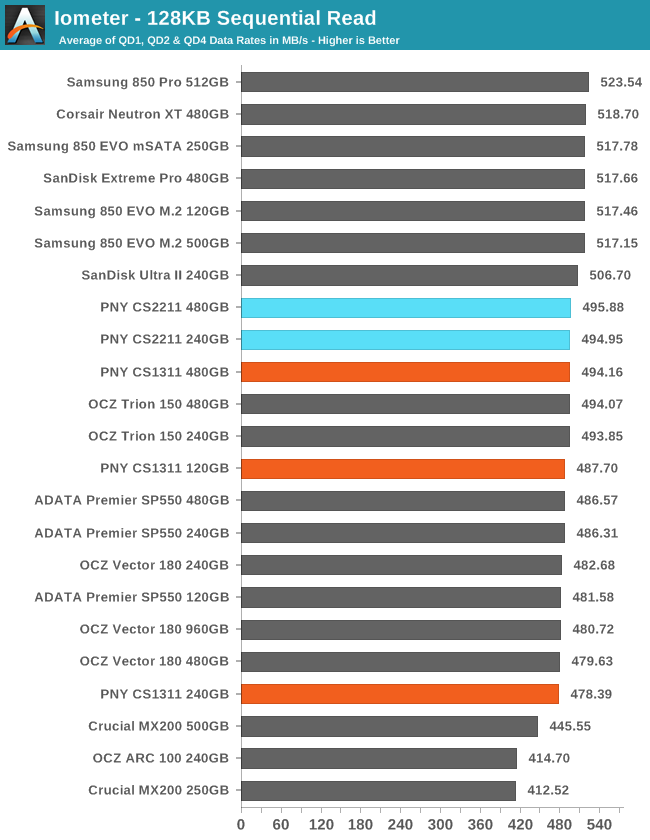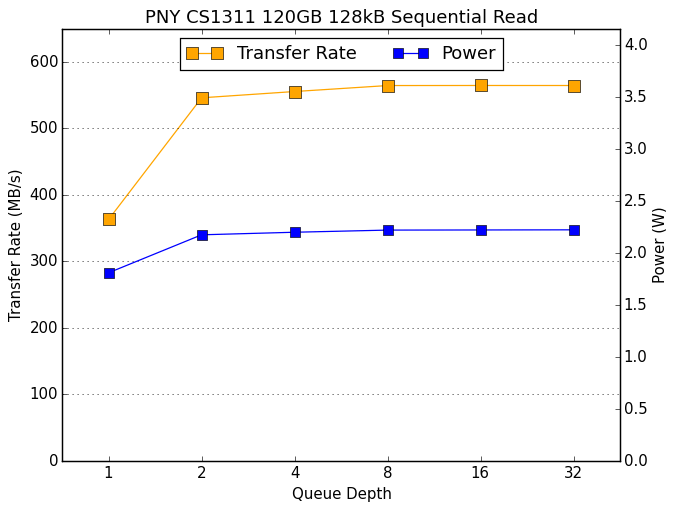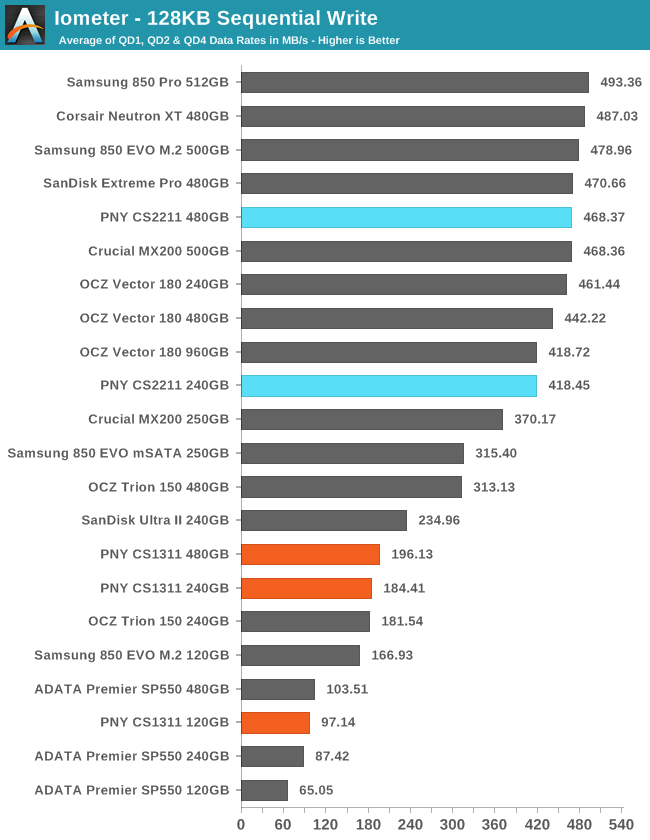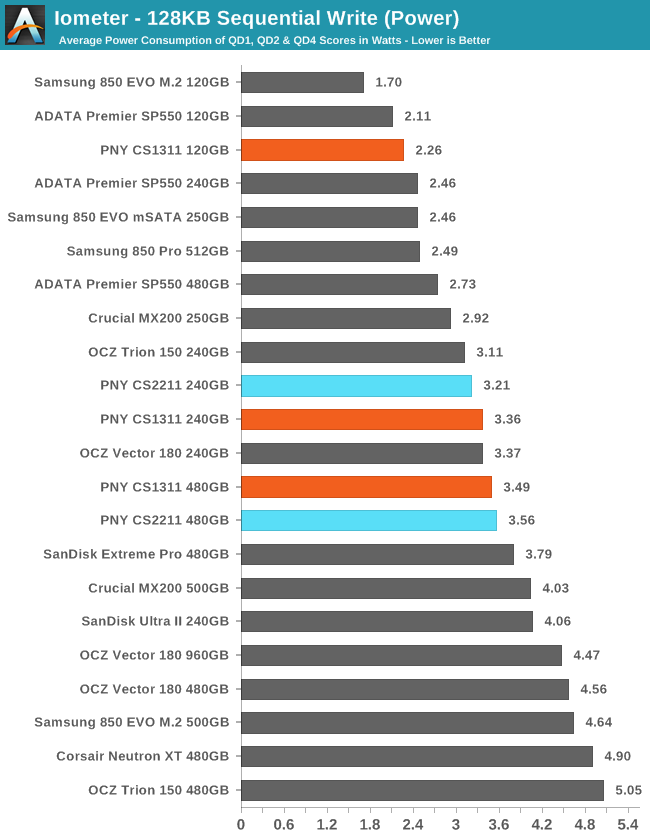The PNY CS1311 and CS2211 SSD Review: MLC vs TLC at 15nm
by Billy Tallis on April 15, 2016 8:00 AM ESTSequential Read Performance
The sequential read test requests 128kB blocks and tests queue depths ranging from 1 to 32. The queue depth is doubled every three minutes, for a total test duration of 18 minutes. The test spans the entire drive, and the drive is filled before the test begins. The primary score we report is an average of performances at queue depths 1, 2 and 4, as client usage typically consists mostly of low queue depth operations.

The sequential read performance of the PNY drives puts them all in the second tier of drives with lots of close competition and nothing to complain about. Choice of flash makes little difference to this benchmark: basically everything can saturate the SATA connection by QD4, so the differences here mostly reflect QD1 performance.

The power consumption shows that the MLC drives are a bit less power-hungry than the TLC drive of the same size (and therefore also more efficient, since the MLC drives are also faster), and that the larger drives are unsurprisingly more power-hungry.
 |
|||||||||
The CS2211 and the largest CS1311 hit full speed at QD2, but the smaller two TLC drives still have a little to gain from QD2 to QD8. Power consumption on all the PNY drives is flat starting at QD2.
Sequential Write Performance
The sequential write test writes 128kB blocks and tests queue depths ranging from 1 to 32. The queue depth is doubled every three minutes, for a total test duration of 18 minutes. The test spans the entire drive, and the drive is filled before the test begins. The primary score we report is an average of performances at queue depths 1, 2 and 4, as client usage typically consists mostly of low queue depth operations.

The sequential write test clearly shows the write performance advantage of TLC over MLC, and the advantage of increased parallelism in larger drives. It's interesting that the 480GB CS1311 has such a small advantage over the 240GB despite having the advantage of an 8-channel controller, while the 120GB CS1311 is clearly starved for parallelism.

Power consumption during the sequential write test is strongly correlated with drive capacity, showing once again that the higher efficiency of MLC is offset by the higher throughput.
 |
|||||||||
The CS1311 actually drops slightly in performance from QD1 to QD2, but is stable after that. The CS2211 gains significantly from QD1 to QD2 and but scales no further.










43 Comments
View All Comments
DanoSpumoni - Saturday, April 16, 2016 - link
When 2TB SSDs drop below $200 then i'll bite... from the current trend it looks like thats only a couple years away maybe lesszodiacfml - Friday, April 15, 2016 - link
It has been like that ever since they unleashed V-NAND drives. Despite being on top, I think they are selling them competitively to remove or not allow smaller players to enter.zepi - Friday, April 15, 2016 - link
At least in Europe Samsung has priced itself out of the game completely. I've yet to see EVO ever even near the top of the GB per euro/£ list when I've been searching for drives. Usually Crucial seems to take to top stop and I've yet to see a reason buy anything else.Like now as I write I see 480GB BX200 being available for 97€ taxes included in amazon.de, cheapest 500GB EVO is 141€, so straight away +45% or something like that. I've yet to see it ever being even remotely competitive with sandisks or corsairs in Europe.
It still seems to sell well though being often in the top lists of many retailers.
DeepLake - Friday, April 15, 2016 - link
Last i checked US prices for Samsung EVO were also very high. I dont know what other commenters are talking about. Are they ignorant or Samsung agents?BrokenCrayons - Friday, April 15, 2016 - link
Thanks for the review. It's good to see SSD prices falling thanks to TLC and a standardized, inexpensive controller. I've been happy with the added capacity at a lower price point thanks to TLC flash. TLC performance behind budget controllers seems good enough now to make MLC SSDs a poor choice in a lot of desktop and laptop usage scenarios.haukionkannel - Friday, April 15, 2016 - link
So true. They Are slover, but the prises are good.hansmuff - Friday, April 15, 2016 - link
They make excellent game drives. With games coming in at 50GB at times, a 480 or 960GB TLC drive with so-so speeds is perfectly acceptable.bug77 - Friday, April 15, 2016 - link
I would love to see the SSD price fall fir any reason but planar TLC :(The performance of planar TLC is not that big of an issue, but the reduced lifetime is.
LostWander - Friday, April 15, 2016 - link
Is the reduced lifetime really that extreme? As far as I've seen it's still far better than anything you would get out of a conventional HDD. Adding in better general performance and it seems like less intensive applications (like a game or media storage drive) would still be perfectly acceptable for TLCbug77 - Friday, April 15, 2016 - link
You get 3 years warranty at most (two years less than MLC/V-NAND TLC) and something like 1000 p/e cycles. Good enough for many things (music, videos), but not if you're writing a lot (e.g. a system drive or a game drive).And while TLC itself is not so bad (it's hardly worth it imho, because it's not much cheaper), if the trend continues we'll have some pretty crappy drives in our hands soon.